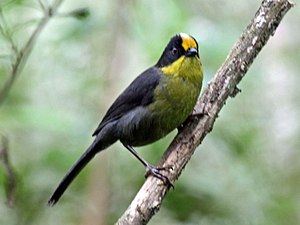Cinnamon browbush
| Cinnamon browbush | ||||||||||||
|---|---|---|---|---|---|---|---|---|---|---|---|---|

Cinnamon-browbush ( Atlapetes pallidinucha ) |
||||||||||||
| Systematics | ||||||||||||
|
||||||||||||
| Scientific name | ||||||||||||
| Atlapetes pallidinucha | ||||||||||||
| ( Boissonneau , 1840) |
The cinnamon-forehead bushhammer ( Atlapetes pallidinucha ) is a species of bird from the family of the New World chambers (Passerellidae). The species has a large range that includes the South American countries Peru , Ecuador , Colombia and Venezuela . The IUCN assesses the population as Least Concern .
features
The cinnamon forehead bushhammer reaches a body length of about 18 centimeters. The top is olive gray with greenish features. The black on the side of the head and on the neck acts like a mask. The wide central stripe on the crown is cinnamon to orange in the front area and fades into white in the rear area. The throat is light yellow. The rest of the underside is yellowish olive green. The olive-colored side and the rump are missing the yellowish coat.
distribution and habitat
The species occurs on the bushy forest edges as well as crooked secondary forest at altitudes of 2500 to 3900 meters on the Papallacta Pass in Ecuador.
behavior
This cinnamon-browbush lives more in the lower stratification layers . In doing so, she behaves rather inconspicuously. They are often seen together with other species such as hooked beaks ( Diglossa ), tanagers (Thraupidae) and other bushhammer ( Atlapetes ). Since it is mainly in the bushes, you can often see it jumping from branch to branch. It feeds on berries, among other things.
Subspecies
Two subspecies are described, which differ mainly in their coloration and their area of distribution:
- Atlapetes pallidinucha pallidinucha (Boissonneau, 1840) nominate form . Occurs in the south of the Venezuelan state of Táchira on the Páramo de Tamá and on the El Retiro and Las Copas mountains . In Colombia the East Andes are his home to the Departamento de Cundinamarca .
- Atlapetes pallidinucha papallactae Hellmayr , 1913 Differs in that the top and bottom are darker. The back, rump, upper tail-coverts, small and medium upper wing coverts are deep soot-black. The underside is dull yellow. The neck stripe is pure white. The beak is noticeably smaller than in the nominate form. The distribution area in Colombia are the central Andes of the Departamento de Antioquia to Nariño . In Ecuador, it is present on the eastern slopes of the Andes in the Napo province on the Papallacta pass. The name of this subspecies also comes from this province. In Peru you can find them on the east in the extreme north of Peru west of the Marañón .
Research history and etymology
Auguste Boissonneau first described this bush hammer under Tanagra (Arremon) pallidinucha . The word Atlapetes for the genus is made up of atla for the Titan Atlas , whose name means bearer, patient and petes from the Greek petros for rock . In ancient mythology, Atlas carried the vault of heaven on his shoulders. The specific epithet comes from Latin and is composed of the words pallida for white and nucha for the neck .
literature
- Steven L. Hilty , William L. Brown: A Guide to the Birds of Colombia. Princeton University Press, 1986, pp. 649f, ISBN 978-0691083728 .
- Steven L. Hilty, John A. Gwynne, Guy Tudor : Birds of Venezuela , Princeton University Press, 2002, p. 809, ISBN 978-0691092508
- Rodolphe Meyer de Schauensee, William H. Phelps , Guy Tudor: A Guide to the Birds of Venezuela. Princeton University Press, 1992, p. 358 ISBN 978-0691082059
- Robert S. Ridgely , Guy Tudor, William Liddle Brown: The Birds of South America. Volume I: The Oscine Passerines. Jays and Swallows, Wrens, Thrushes, and Allies, Vireos and Wood-Warblers, Tanagers, Icterids, and Finches. University of Texas Press, 1989, ISBN 9780292707566 , p. 429.
- Thomas Schulenberg , Douglas F. Stotz , Daniel F. Lane: Birds of Peru. Princeton University Press, 2007, ISBN 978-0-691-04915-1 , p. 604.
- Robert S. Ridgely, Paul J. Greenfield: Birds of Ecuador Field Guide , Vol. 1, Cornell University Press, 2001, pp. 781f, ISBN 978-0-8014-8720-0
- Robert S. Ridgely, Paul J. Greenfield: Birds of Ecuador Field Guide , Vol. 2, Cornell University Press, 2001, p. 686, ISBN 978-0-8014-8721-7
Web links
- Videos, photos and sound recordings of Pale-naped Brush-finch (Atlapetes pallidinucha) in the Internet Bird Collection
- Image on Flickr Pale-naped Brush-Finch (Atlapetes pallidinucha)
- Avibase cinnamon-browbush (Atlapetes pallidinucha) pictures and more information
- Mangoverde Pale-naped Brush-Finch Atlapetes pallidinucha Fig
- Antipitta Pale-naped Brush-Finch Atlapetes pallidinucha papallactae Pictures of various Sparrows and finches -Embrizidae
Individual evidence
- ↑ Atlapetes pallidinucha in the IUCN Red List of Threatened Species 2010.3. Listed by: BirdLife International, 2009. Retrieved October 16, 2010.
- ↑ Negotiations of the Ornithological Society in Bavaria 1913 page 318f Atlapetes pallidinucha papallactae n. Subsp.
- ↑ Revue zoologique par la Société cuviérienne 1840 p. 68 Oiseaux nouveaux ou peu connus de Santa-Fé de Bogota T. (Arremon) pallidinucha (French)